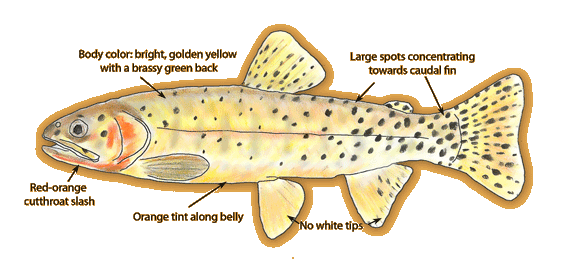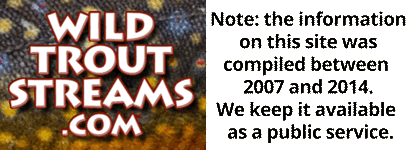
Illustration by Steven Schalla, FlyFishingtheSierra.com, used with permission
Greenback cutts were considered Endangered until the 1990s. Extensive conservation work expanded their range from 9 populations to several dozen, and the trout was honored as the "State Fish of Colorado", and downgraded to "threatened".
That is, until DNA testing gummed up the works. Greenback and CRCT cutts are morphologically indistinguishable from each other (even if you're a trained fish biologist in a lab, dissecting the specimens). You can ONLY reliably tell the difference via genetic testing. Prior to that, fisheries managers simply assumed that any wild cutthroat population they found in the front range, where there was no record of stocking, was Greenback. That turned out to be wrong: recent testing has shown that virtually every population that was assumed to be Greenback is, in fact, a wild survivor of CRCT trout stocked in the late 19th and early 20th centuries, where the records had been lost. All of the transplanted conservation populations used brood stock from these formerly CRCT pops. Only ONE of the historic populations currently identified as "Greenback" is in fact genetically Greenback. Angling on that stream, by the way, is prohibited and "true" Greenbacks are back on the endangered list.
So, if you're fishing legally for Greenbacks, you're really fishing for a wild cutthroat on the East Slope that's not RGCT. As with all cutthroats, check first for the distinct orange-red cutthroat slash below the jaw. Greenback is one of the most colorful, and will often exhibit a bright golden yellow body with a brassy green back and an orange to red tint along the belly (especially in males). Spots tend to be the largest and most pronounced of any cutthroat trout. Round to oblong in shape, the spots appear concentrated posteriorly on the caudal peduncle area.
Distinguishing the Colorado from the Rio Grande - is difficult as there is substantial overlap in appearance. Rio Grande cutthroat trout possess similar, though sometimes duller coloration. They have fewer scales in and above the lateral line and more irregularly shaped spots on the caudal peduncle. More reliable is distinguishing cutthroat by location. If you're on the East Slope, north of the Rio Grande drainage and you catch a wild cutthroat, it's almost certainly a "Greenback".
Distinguishing the Greenback from its more northern and western cousins is somewhat easier: a Yellowstone will have a drabber, yellowish brown, silvery, or brassy color body becoming paler by the belly, with medium sized spots; a Snake River Cutt will have drabber body color and many more, smaller spots; a Westslope Cutt will generally exhibit bright but different colors, with a yellow, orange, and red body, and more, smaller spots that won’t appear below the lateral line except near the tail; the Bonneville will have drabber coloration.

